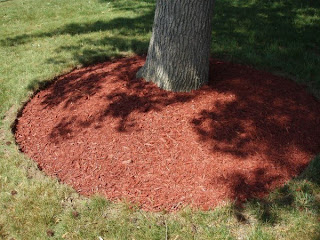
What are the Benefits of Mulching?
Is mulching necessary, is a very common question asked by many people. Yes, proper mulching under trees is necessary for a tree's health. Read these benefits of mulching to know what makes mulching trees necessary. Mulching around trees helps in preventing soil erosion. Mulching prevents light from reaching the surface of the soil. This prevents any weed growth. So, mulching for weed control is a good idea. As the mulch decays, it enriches the soil by adding nutrients to it. Thus, using the product obtained from composting as a mulch for trees, acts as a good fertilizer. Mulching helps the soil to retain the moisture, thus preventing evaporation. A mulch is a slope around the tree or plant. So, the possibility of a lawn equipment like lawn mowers running over a tree or shrub is less, due to mulching. In gardening, mulch is very commonly used to beautify the area.
What are the Different Types of Mulch?
There are two types of mulch - organic and inorganic. Organic mulch is prepared using natural substances. These substances include leaves, bark of trees, grass, vegetable waste, etc. Organic mulch contains natural substances and therefore it decomposes easily. Inorganic mulch is a mixture of both natural and artificial substances like, pebbles, rubber, black plastic, etc. Inorganic mulch does not decompose. They are a good choice, if you have a weed problem.
How Much to Mulch?
Mulches should be 2 - 4 inches high for trees. This is the appropriate height required for mulching, which gives an effective covering to the soil. However, to calculate the amount of mulch required, there are two major factors to be considered. The first one is the square foot area of your garden and the second factor is the amount of mulch depth, you want, in inches. To calculate the square foot of the mulch area, calculate the total area of the garden and subtract the plant area occupied. This is the area where you can lay the mulch. Knowing the regular thickness of mulch, according to different constituting substances also helps in making an easy decision. For example, if the mulch is made of compost, the thickness will be around 1 - 3 inches, for a mulch made of leaves, it will be 4 - 5 inches thick, and a peat moss mulch will be about 1 inch thick.
How to Mulch Around Trees?
The first step in how to mulch around trees, is to clean the area before applying the mulch. Remove all the grass, weeds and leaves near the tree. Create a circular border of stones around the trees. This border should be of 3 inches diameter. Using your hands, spread the mulch. Make a mulch of the required thickness. Settle the mulch by watering it. This method can be also used for mulching fruit trees and flower trees.
To mulch around plants, follow this method. Clean the area of any weeds or leaves. Form a circle made of medium-sized rocks. This circle should be around 2 and a half inches. Spread a 2 inches thick layer of mulch with your hands. Also, make sure that the mulch is at least 2 inches away from the stems of the plant.
What is the Right Time for Mulching?
Mulching around trees or plants is beneficial throughout the year. However, follow these mulching tips for different seasons. For autumn, use a thick layer of mulch for the trees around 4 inches high. In winter, provide the trees with an extra one inch thickness of mulch. Mulching in the spring time, should be done after the soil warms. For tomato plant, use mulching after the tomatoes blossom.
These were some of the FAQ's about mulching around trees. Here are some more tips which will help you in mulching around trees.
- Prepare individual mulch according to the type of tree or plant.
- Check the thickness of the mulch regularly. If required add more mulch, to meet the standard mulch thickness.
- Sometimes there will be lumps formed in the mulch. Use your hands to break these lumps.
- Do not pile up the mulch against the stem of the plant or tree trunk.
- Organic mulch is more popular. If you are using organic mulching under trees, keep it well aerated and well drained.
- If you face drainage problems with the mulch, decrease an inch of the mulch thickness.
- Avoid sour mulches as they give out a pungent smell. These mulches can prove harmful for young plants as they might produce toxic elements over some time.
- Prevent excessive moisture in the mulch. This might lead to rotting of the roots.
- Excessive mulching may lead to infestation by rodents and spread of certain diseases.
No comments:
Post a Comment